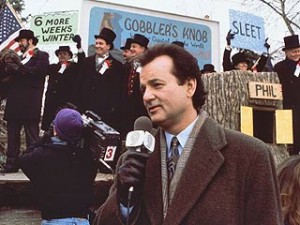In the iconic movie Groundhog Day, Bill Murray’s character Phil Connors keeps waking up on the same day (Groundhog Day), in the same place (Punxsutawney, Pennsylvania) and reliving that day over and over while the people around him go about as if nothing odd were happening.
If you’re reading this today (February 3rd), you’re definitely not stuck in the vicious cycle Phil Connors was stuck in but you might be able to relate. At some offices, it can feel like your own personal Groundhog Day: walking into the same place, fighting the same battles, and making no progress day after day.
Sure, maybe the seasons change. Maybe you tried a different coffee stop on the way to work to try and break the chain. But if you actually want to put an end to the cycle, it is time to do something about it.
The mistake of doing nothing
When you get into that sort of situation, you might think waiting it out is going to be the best plan. You might think that change might be just slow or temporarily stalled. Then you wait. And wait a little longer.
In a situation like that, it might be easy to sit back and wait. In fact, if you look around at the people you work with, you might see that same attitude. It’s a toxic environment and I’ve been there before. You might start thinking it is okay to punch it in for weeks on end because that’s what everyone else is doing.

Not only is that a bad thing to do for the people who employ you, it is bad for your own self-discipline. If you are naturally a doer at work, getting out of that habit makes it a lot harder to get back into it. It is better to keep pushing, even if it is for your personal benefit only.
How to make things move in a static office
When you and everyone around you are stuck in that cycle, it can seem like moving a mountain to get anything done. There are some things you can do to help move things along, however.
- Map out how things work – Whenever I figured out I was stuck in my own personal Groundhog Day, I used the first part of my time to figure out how decisions were made and who were people that would hold up or help push through projects. This is when HR can put on their work-flow process caps on for their own benefit. In a static office, this exercise shouldn’t be too difficult.
- Support other people’s changes first – When you start to explore the organizational structure, you’ll find people who want to make some changes or start some projects. The best thing you can do is figure out what they want to do and get behind it. In one instance, I was able to help push through an IT security issue via an HR channel. It wasn’t a big deal (and it was a good change) but it got me an ally.
- Figure out the multiple ways to push – This is a political process. Some managers don’t like to be gone around. Others are seen as a roadblock by superiors, so it might not be that big of deal even if they don’t personally like it. While you might not be at work to make friends, certainly personal relationships do impact the way people interact in the office. Embrace the politics of it but don’t be afraid to go outside the lines, even if it is only once or twice.
- Execute on your end – Don’t ever let yourself be the hold up. That means getting your stuff done early, even if you know it is going to be a month before someone is willing to sign off on. That way, if they get an opportunity to talk to you about it, you’ll be ready to go with something they can sign off on right away.
- Be generous with credit and keep going – When someone helps you out (even begrudgingly) on a successful project, make sure to heap buckets of praise on the person and their manager. Now isn’t the time to get egotistical about who is getting stuff done around the office. Sharing the praise will only help you get more things done in the future and getting more successful projects and changes off the ground is only going to help you.
This is a critical skill for HR pros to have and it can be a real game changer. You would also be surprised how many of your once slothful co-workers are now willing participants once the gears in your office start moving again.
How have you initiated change or new projects in a tough office environment?
